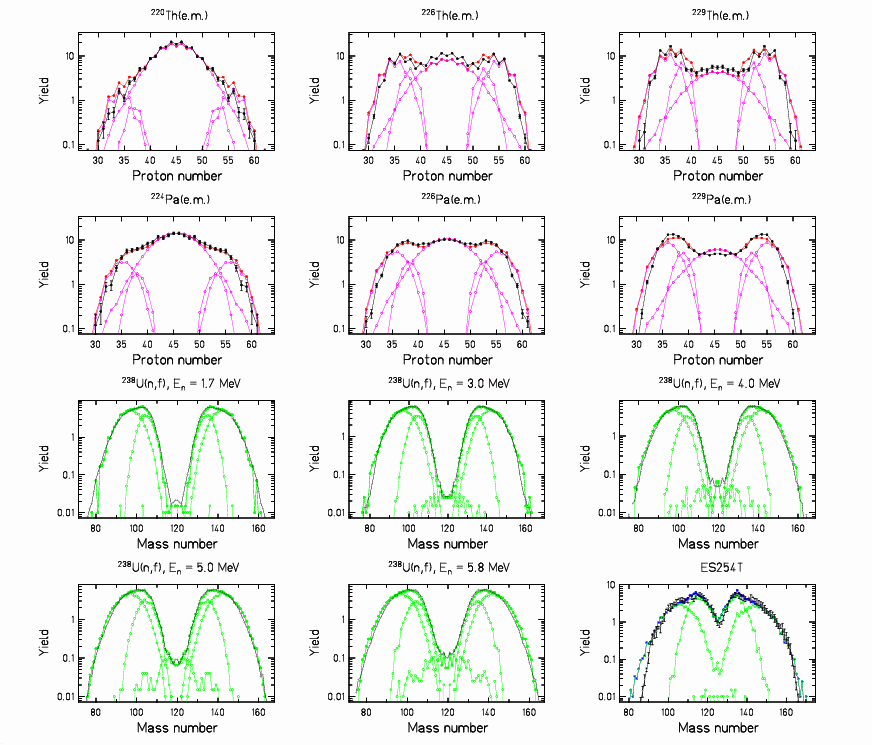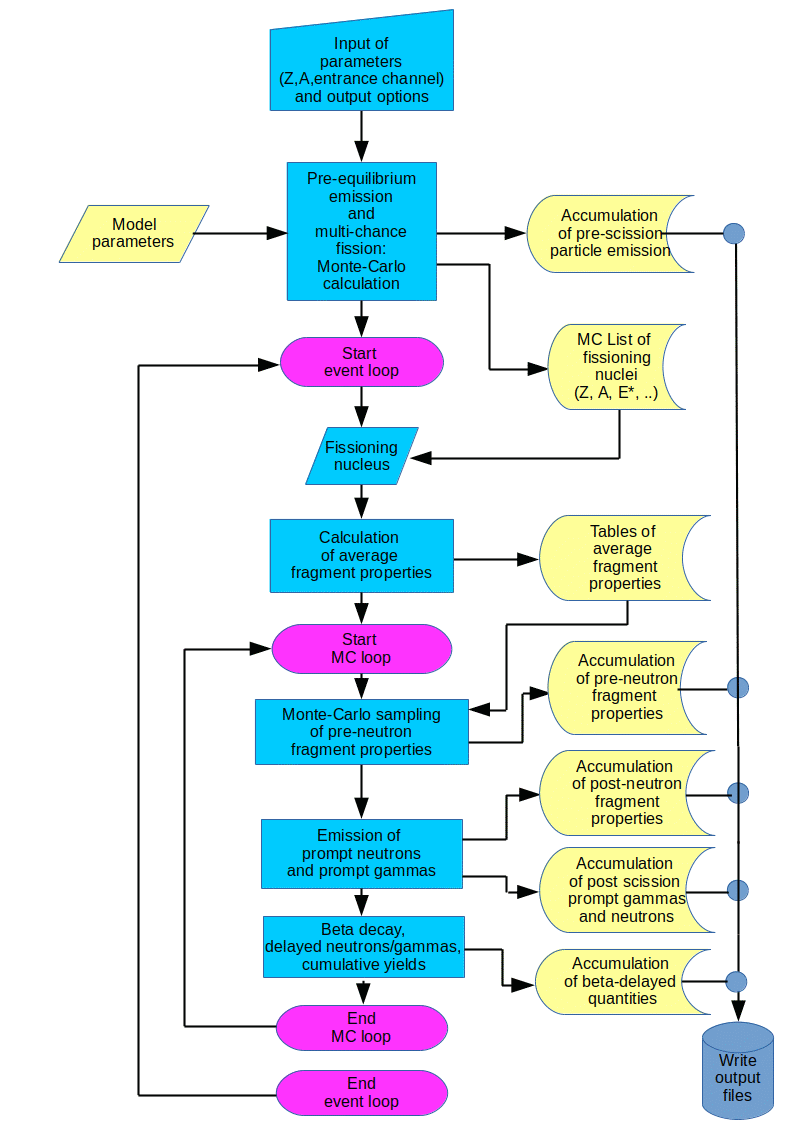GEF
A
General
Description of Fission
Observables
Items on
this page
Description of the
model
The model has been developed with the aim to provide dedicated nuclear
data for applications in nuclear technology and engineering. The code
considers spontaneous fission and fission up to an excitation energy of
about 100 MeV (including multi-chance fission) for a wide range of
heavy
nuclei from polonium to seaborgium. The development of GEF has been
supported by the European Union in the framework of the EFNUDAT project
(http://www.efnudat.eu/), of the
ERINDA project (http://www.erinda.org/), of the CHANDA project
(http://www.chanda-nd.eu/) and, during the years 2010 - 2016, by the
OECD Nuclear Energy Agency. A
detailed description of the physics of the code is given in the JEFF-Report 24
of the Nuclear-Energy Agency of the OECD.
Executables of the GEF code for Windows[a] and Linux are
available. They are easy to use: Just download the ZIP file,
extract the files and
run GEF.bat (Windows [a]) or ./GEF (Linux) in a command window on your
computer! The file README.txt
contains further information.
[a] Windows is either a registered trademark or a trademark of
Microsoft
Corporation in the United States and/or other countries.

Empirical fission-fragment Z and mass distributions compared with GEF
calculations.
Main
ingredients of the model
- The mass division and the charge polarization are
calculated
assuming a statistical population of states in the fission valleys at
freeze-out. The freeze-out time considers the influence of fission
dynamics and is not the same for the different collective variables.
- The separability principle [1] governs the interplay of
macroscopic and microscopic effects.
- Five fission channels are considered. The strengths of the
shells
in the fission valleys are identical for all fissioning systems. The
mean positions of the heavy fragments in the asymmetric fission
channels are essentially constant in atomic number, as suggested by
experimental data [2]. (Read
more.)
- New
(since GEF-Y2023/V3.1): In lighter actinides, fission paths with
extremely compact and extremely elongated configurations are suppressed
for low excitation energies at freeze-out. The yields of the S1 and the
S3 channel, as well as the shape of the S2 channel are affected. This
effect is tentatively attributed to the inflluence of the
third barrier. Its height is estimated by extrapolating the trend from
the first to the second barrier.
- The stiffness of the macroscopic potential with respect to
mass
asymmetry is deduced from the widths of measured mass distributions of the symmetric fission channel [3].
- The excitation-energy-sorting mechanism [4,5,6,7]
determines the
prompt neutron yields and the odd-even effect in fission-fragment
yields of even-Z and odd-Z systems. (Read
more.)
- Neutron evaporation is calculated with a Monte-Carlo
statistical
code using level densities from empirical systematics [8] and binding
energies with theoretical shell effects [9] with gamma competition
included.
References:
[1] Experimental evidence for the separability of
compound-nucleus
and fragment properties in fission, K.-H. Schmidt, A. Kelic,
M. V.
Ricciardi, Europh. Lett. 83 (2008) 32001
[2] Nuclear-fission studies with relativistic secondary
beams:
analysis of fission channels, C. Boeckstiegel et
al., Nucl.
Phys. A 802 (2008) 12
[3] Shell effects in the symmetric-modal fission of
pre-actinide
nuclei, S. I. Mulgin, K.-H. Schmidt, A. Grewe, S. V. Zhdanov,
Nucl.
Phys. A 640 (1998) 375
[4] Entropy-driven excitation-energy sorting in superfluid
fission
dynamics,
K.-H. Schmidt, B. Jurado, Phys. Rev. Lett. 104 (2010) 212501
[5] Influence of complete energy sorting on the
characteristics of the odd-even effect in fission-fragment element
distributions, B. Jurado, K.-H. Schmidt, J. Phys. G: Nucl.
Part. Phys. 42 (2015) 055101
[6] Thermodynamics of nuclei in thermal contact,
K.-H. Schmidt,
B. Jurado, Phys. Rev. C 82 (2011) 014607
[7] Final excitation energy of fission fragments,
K.-H.
Schmidt, B. Jurado, Phys. Rev. C 83 (2011) 061601(R)
[8] Inconsistencies in the description of pairing effects in
the
nuclear level densities, Phys. Rev. C 86 (2012) 044322
[9] Global view on
fission observables - new insights and new puzzles, K.-H.
Schmidt, B. Jurado, Phys. Proc. 31 (2012) 147
[10] General description of fission
observables - GEF model, K.-H. Schmidt, B.
Jurado, Ch. Amouroux, JEFF-Report 24, Data Bank, Nuclear-Energy Agency,
OECD, 2014
[11] Revealing hidden
regularities with a general approach to fission, K.-H.
Schmidt, B. Jurado, Eur. Phys. J. A 51 (2015) 176
[12] General
description of fission observables: GEF model code, K.-H.
Schmidt, B. Jurado, C. Amouroux, C. Schmitt, Nucl. Data Sheets 131
(2016) 107
[13] Influence of
complete energy sorting on the characteristics of the odd-even effect
in fission-fragment element distributions, B. Jurado,
K.-H. Schmidt, J. Phys. G: Nucl. Part. Phys. 42 (2015) 055101 [arXiv:
14411.4478]
[14] Review on the
progress in nuclear fission - experimental methods and theoretical
descriptions, K.-H. Schmidt, B. Jurado, Rep. Progr. Phys.
81 (2018) 106301
[15] Extensive study of the quality of fission yields from
experiment, evaluation and GEF for antineutrino studies and
applications, K.-H. Schmidt, M. Estienne, M. Fallot, S. Cormon, A.
Cucoanes, T. Shiba, B. Jurado, K. Kern, Ch. Schmitt, Nucl. Data Sheets
173 (2021) 54
[16]
Experimental evidence for common driving effects in low-energy fission
from sublead to actinides, C. Schmitt, A. Lemasson, K.-H. Schmidt, A.
Jhingan, S. Biswas, Y. H. Kim, D. Ramos, A. N. Andreyev, D. Curien, M.
Ciemala, E. Clement, O. Dorvaux, B. De Canditiis, F. Didierjean, G.
Duchene, J. Dudouet, J. Frankland, B. Jacquot, C. Raison, D. Ralet,
B.-M. Retailleau, L. Stuttge, I. Tsekhanovich, Phys. Rev. Lett. 126
(2021) 132502
[17] Evidence for the general dominance of proton
shells in low-energy fission, K. Mahata, C. Schmitt, Shilpi Gupta, A.
Shrivastava, G. Scamps, K.-H. Schmidt, Phys. Lett. B 825 (2022) 136859
[18] Identifying and overcoming deficiencies of nuclear data on the fission of light actinides by use of the GEF code (Preprint: https://hal.in2p3.fr/in2p3-04489502 )
Flowchart of GEF

GEF_code/Flowchart-GEF-delayed.gif
Flowchart of the GEF code.
Required
input of GEF
Z and A of fissioning nucleus or target
Excitation mode and excitation energy (eventually energy distribution)
Output options
Quantities
available
on output of GEF
Contributions of fission chances (multi-chance fission)
Relative yields of fission channels
Element-yield distribution *)
Isotonic-yield distribution (pre- and post-neutron)
Isobaric-yield distribution (pre-and post-neutron) *)
Mass-chain yields (pre- and post-neutron) *)
Fragment angular-momentum distributions (for every nuclide)
Relative independent isomeric yields
Prompt-gamma spectrum
Prompt-neutron spectrum
Neutron-multiplicity distribution
Fragment total kinetic energy (pre- and post-neutron)
Energies and directions of pre- and post-scission prompt neutrons
Many more quantities are internally calculated and may be
listed.
An extended version of
GEF that
includes delayed processes (output of delayed-neutron multiplicities,
delayed-neutron emitters, cumulative fission-fragment yields in ENDF
format etc.) is available on this web for the most recent GEF versions.
*) Uncertainties of fission yields from perturbed-parameter calculations
and covariences of fission-fragment yields.
Download
GEF code, version 2025.1.2 (Release: June 25, 2025, last update: November 23, 2025)
GEF code, version 2025.1.1 (Release: April 6, 2025)
GEF code, version 2024.1.1 (Release: October 24, 2024)
GEF code, version 2023.3.3 (Release: August 2, 2024)
GEF code, version 2023.3.2 (Release: December 16, 2023, last update January 14, 2024)
GEF code, version 2023.3.1 (Release: November 13, 2023)
GEF code, version 2023.2.2 (Release: July 16, 2023, last update Sept. 5, 2023)
GEF code, version 2023.2.1 (Release: April 14, 2023)
GEF code, version 2023.1.2 (Release: March 11, 2023, last update March 15, 2023)
GEF code, Version 2023.1.1 (Release: January 12, 2023, last update March 7, 2023)
GEF code, Version 2021.1.1 (Release: June 2, 2021, GEFSUB.FOR last update May 23, 2022)
GEF code, Version 2020,1.2 (Release: December 4, 2020, last update January 4, 2021)
GEF code, Version 2020,1.1 (Release: July 30, 2020, last update September 18, 2020)
GEF code, Version 2019/1.3 (Release: February 2, 2020; last update April 27, 2020)
GEF code, Version 2019/1.2 (Release: September 4, 2019; last update April 9, 2020)
GEF code, Version 2019/1.1
(Release: February 5, 2019; last modification June 6, 2019)
GEF code. Version 2018/1.1
(Release: June 21, 2018)
GEF code, Version 2017/1.2
(Release: October 18, 2017; last modification January 30, 2018)
GEF code, Version 2017/1.1
(Release: September 24, 2017)
GEF code, Version 2016/1.2
(Release: November 26, 2016)
GEF code, Version 2016/1.1
(Release: October 14, 2016)
GEF code, Version 2015/2.2
(Release: September 22, 2015, numerical stability improved on September
23, 2015,
technical modifications on October 3, November
26, 2015, April 11,
April 29, May 29, July 2, and Sept. 7, 2016.)
(Description of non-statistical prompt gamma energies with a new VMI
model,
Improved description of fission chances and fission-fragment
distributions for highly excited systems.
Improved description of fragment distributions for light fissioning
systems (Z = 76 to 90).
Note: GEF Version 2015/2.1 should not be used any more.
GEF code, Version 2015/1.1
(Release: January 2, 2015, numerical stability improved on September
23, 2015)
(Extended output options, covariances between results of different
systems.)
GEF code, Version 2014/2.1
(March 25, 2014)
(New global parameter set, new systematics of fission barriers)
GEF code, Version 2014/1.2
(January 25, 2014)
(Modified description of multi-chance fission.)
GEF code, Version 2014/1.1
(January 4, 2014)
(New global parameter set, modifications for better description of
multi-chance fission.)
GEF code, Version 2013/2.2
(December 6, 2013)
(Even odd effect in fission-fragment neutron-number distribution
revised.
Mass distribution at high excitation energies revised.
Prompt-neutron emission improved.
Output of pre-fission and post-scission neutrons extended.
Influence of temperature dependent shape oscillations on
prompt-neutron emission considered.
Fission-gamma competition refined.
New global parameter set.
Multi-chance fission modified.
Spurious even-odd effect in fission probabilities removed.)
Supplemental and help information
- Help
information for reading a covariance or correlation matrix from the GEF
output file
The covarience or correlation matrix of nuclide yields (specified in Z and A) is listed in
a special format.
The program ReadCorr is provided that interprets the data structure and lists the
4-dimensional (Z1, A1, Z2, A2) coordinates and the corresponding matrix
values. This program may help you to read the matrices from the GEF
output with your own software.
- Guide for the
production of covariance and correlation matrices with GEF
The technical parameters for the production of
variances
(and the corresponding uncertainties), covariances and correlations are
discussed, and their influence on the qualitiy of the data is
investigated
and demonstrated this report.
Authors: Beatriz Jurado (jurado (at) cenbg.in2p3.fr)
and
Karl-Heinz Schmidt (khschmidts-nuclear web.eu).

